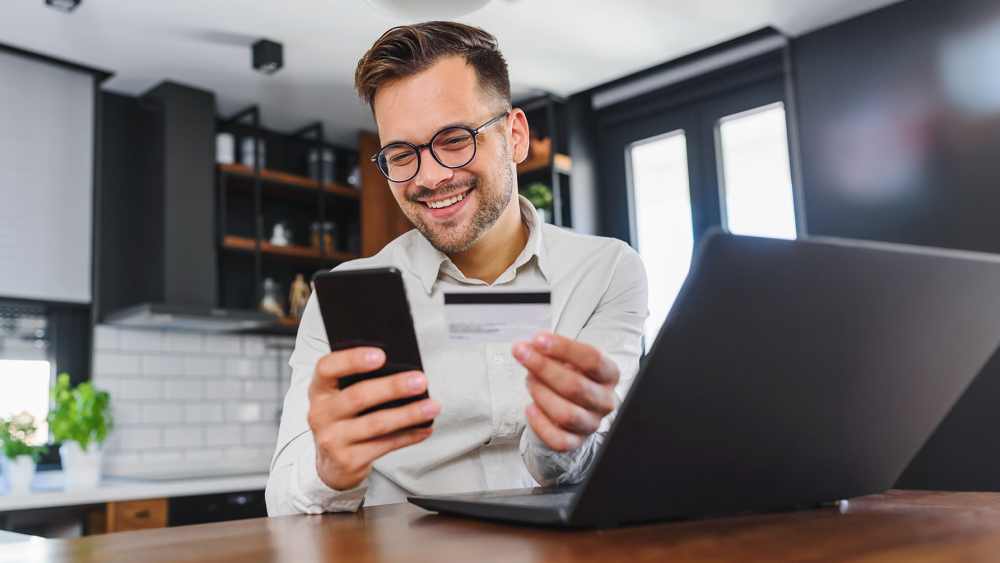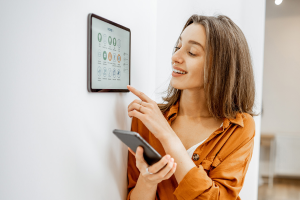Mobile banking is highly secure — when you take a few straightforward steps, it becomes even safer.
And those steps only take minutes, leaving you and your finances far more secure than before.
Use strong passwords.
Start here. Strong and unique passwords for each of your accounts form your first line of defense. However, one thing that can be a headache is the number of passwords we have to juggle — a number that seems like it’s growing every day. To help with that, you should strongly consider using a password manager. A good choice generates strong, unique passwords for each of your accounts and stores them securely for you.
If you want to set up your own passwords, check out this article on how you can make them strong and unique.
Use two-factor authentication to protect your accounts.
Two-factor authentication is practically a banking standard nowadays. What exactly is two-factor authentication? It’s an extra layer of defense for your accounts. With two-factor authentication, you also receive a special one-time-use code when logging in. That code might be sent to you via email or to your phone by text. In some cases, you can also receive that code by a call to your phone. In all, this makes it much tougher for a hacker to hijack your account.
Quick note — never share your unique code with anyone. If someone asks you for it at any time, it’s a scam.
Keep an eye out for phishing attacks.
Scammers use phishing attacks to steal personal info through emails, texts, and even social media messages. In the case of banking, they look to phish (“fish”) personal and financial info out of you by posing as your bank. They typically make their message sound urgent, like your account shows some unusual activity.
When you get these messages, always check the sender. Is the address or phone number one that your bank uses? And note that scammers often “spoof” addresses and phone numbers — making them look legit even though they’re fake. If you’re ever unsure, don’t reply. Contact your bank directly to see if your account indeed has an issue. Also, ignore such messages on social media. Banks don’t use social media messages to contact their account holders.
Yet better, you can use our Text Scam Detector to detect the sketchy links scammers use in their attacks. AI technology automatically detects scams by scanning URLs in your text messages. If you accidentally tap? Don’t worry, it can block risky sites if you tap on a suspicious link in texts, emails, social media, and more.
Be skeptical about calls as well. Fraudsters use the phone too.
It might seem a little traditional, yet criminals still like to use phone calls. In fact, they rely on the fact that many still see the phone as a trusted line of communication. This is known as “vishing,” which is short for “voice phishing.” The aim is the same as it is with phishing. The fraudster is looking to lure you into a bogus financial transaction or attempting to steal info, whether that’s financial, personal, or both.
The same advice applies here. End the call and then dial your bank directly to follow up.
Steer clear of financial transactions on public Wi-Fi in cafes, hotels, and elsewhere.
There’s a good reason not to use public Wi-Fi: it’s not private. They’re public networks, and that means they’re unsecured and shared by everyone who’s using it. With that, determined hackers can read any data passing through them like an open book. And that includes your accounts and passwords.
Instead of public Wi-Fi, use your smartphone’s data connection, which is far more secure. Yet better, consider connecting with a VPN. Short for a “virtual private network,” a VPN helps you stay safer with bank-grade encryption and private browsing. Think of it as a secure tunnel for your data, which keeps unwanted eyes from snooping. It’s a particularly excellent option if you find yourself needing to use public Wi-Fi, as a VPN effectively makes a public network connection private.
Protect your banking and finances even further
Some basic digital hygiene goes a long way toward protecting you even more. It’ll protect your banking and finances and all the things you do online as well.
Update your software.
That includes the operating system of your computers, smartphones, and tablets, along with the apps that are on them. Many updates include security upgrades and fixes that make it tougher for hackers to launch an attack.
Lock up.
Your computers, smartphones, and tablets have a way of locking them with a PIN, a password, your fingerprint, or your face. Take advantage of that protection, which is particularly important if your device is lost or stolen.
Use security software.
Protecting your devices with comprehensive online protection software fends off the latest malware, spyware, and ransomware attacks. Online protection like our McAfee+ plans further protects your privacy and identity in several ways:
- Credit Monitoring helps you keep an eye on changes to your credit score, report, and accounts with timely notifications. Spot something unusual? It offers guidance so you can tackle identity theft.
- Identity Monitoring checks the dark web for your personal info, including email, government IDs, credit card and bank account numbers, and more. If any of it shows up on the dark web, it sends you an alert with guidance that can help protect you from identity theft.
- Our online protection software also offers several transaction monitoring features. They track transactions on credit cards and bank accounts — shooting you a notice if unusual activity occurs. They also track retirement accounts, investments, and loans for questionable transactions. Finally, further features can help prevent a bank account takeover and keep others from taking out short-term payday loans in your name.
- And finally, should the unexpected happen, our Identity Theft Coverage & Restoration can get you on the path to recovery. It offers up to $2 million in coverage for legal fees, travel, and funds lost because of identity theft. Further, a licensed recovery pro can do the work for you, taking the necessary steps to repair your identity and credit.












